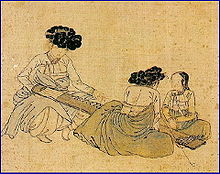Geomungo
This article needs additional citations for verification. (April 2021) |
| Geomungo | |
 | |
| Korean name | |
|---|---|
| Hangul | |
| Hanja | |
| Revised Romanization | geomun(-)go or hyeon(-)geum |
| McCune–Reischauer | kŏmun'go or hyŏn'gŭm |
The geomungo (also spelled komungo or kŏmun'go) or hyeongeum (literally "black zither", also spelled hyongum or hyŏn'gŭm) is a traditional Korean plucked zither with both bridges and frets. Geomungo is a representative stringed instrument made in Goguryeo before the 5th century.[1] Scholars believe that the name refers to Goguryeo and translates to "Goguryeo zither" or that it refers to the colour and translates to "black crane zither" (hyeonhakgeum, 현학금 / 玄鶴琴).
The geomungo's place in Korean culture is traditionally that of a scholars' instrument for self-cultivation, much like ancient Chinese had done with the guqin in China.[2]
History[]

The instrument originated circa the 4th century (see Anak Tomb No.3 infra) through the 7th century from the kingdom of Goguryeo, the northernmost of the Three Kingdoms of Korea, although the instrument can be traced back to the 4th century.[3]
According to the Samguk Sagi (Chronicles of the Three Kingdoms), written in 1145, the geomungo was invented by prime minister Wang San-ak by using the form of the ancient Chinese instrument guqin (gogeum, also called chilhyeongeum, literally "seven-string zither"). After his death, the instrument was passed down to Ok Bogo, Son Myeong-deuk, Gwi Geum, An Jang, Cheong Jang, and Geuk Jong, while being widely spread over the kingdom.
Archetype of the instrument is painted in Goguryeo tombs. They are found in the tomb of Muyongchong and Anak Tomb No.3.[3]
Construction[]
The geomungo is approximately 162 cm long and 23 cm wide (63.75 inches long, 9 inches wide), and has movable bridges called Anjok and 16 convex frets. It has a hollow body where the front plate of the instrument is made of paulownia wood and the back plate is made of hard chestnut wood. Its six strings, which are made of twisted silk passed through its back plate. The pick is made from bamboo sticks in the size of regular household pencil. Three strings are directly over the frets which can be stopped whilst the other three are open strings.
Modernized geomungo increases the strings to 11, which are made of nylon. As with the traditional version, three strings are over the frets and the others are all open. But the traditional version of the geomungo has 6 strings, with three over the frets.
Recently, the 6-string Geomungo has been improved quite a lot, with the appearance of electronic geomungo (전자 거문고). Geomungo playing with Hwaldae bow (활대 거문고) (same as playing ajaeng),[4] or the type of geomungo having more strings, collected; attracted the attention of young artists.
In the development of culture, besides the conservation artists, inheriting the cultural tradition of the nation, there are artists who change and modernize the traditional culture of the nation.
Playing method[]
The geomungo is generally played while seated on the floor. The strings are plucked with a short bamboo stick called suldae, which is held between the index and middle fingers of the right hand, while the left-hand presses on the strings by either pulling or pushing to produce various pitches. The most typical tuning of the open strings for the traditional Korean music is D#/Eb, G#/Ab, C, A#/Bb, A#/Bb, and A#/Bb an octave lower than the central tone. The instrument is played in traditional Korean court music and the folk styles of sanjo and sinawi.[5]
Due to its characteristically percussive sound and vigorous playing technique it is thought of as a more "masculine" instrument than the 12-string or 24 string gayageum (another Korean zither); both instruments, however, are played by both male and female performers.
The geomungo has a large range of playable songs and also has a large range of tunes.
The Korean-born, U.S. resident geomungo performer and composer Jin Hi Kim plays a custom-made electric geomungo in addition to the regular instrument.[6]
See also[]
- Korean music
- List of Korea-related topics
- Traditional Korean musical instruments
References[]
- ^ "거문고 - 한국민족문화대백과사전". encykorea.aks.ac.kr. Retrieved 2021-05-10.
- ^ "Geomungo". TeRra Magazine. 2018-07-30. Retrieved 2019-09-28.
- ^ a b [1][dead link]
- ^ "'첼로 거문고?'...국악기는 변신 중". YouTube. Retrieved 21 April 2021.
- ^ [2][dead link]
- ^ "Photographic image" (JPG). Mediateletipos.net. Retrieved 21 April 2021.
External links[]
| Wikimedia Commons has media related to Geomungo. |
- Goguryeo
- Korean musical instruments
- Zithers
- Important Intangible Cultural Properties of South Korea
- Asian musical instruments